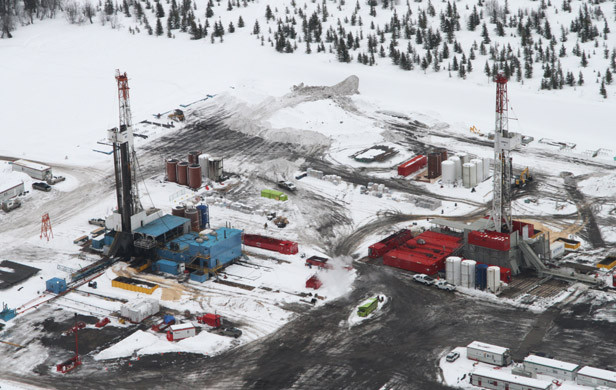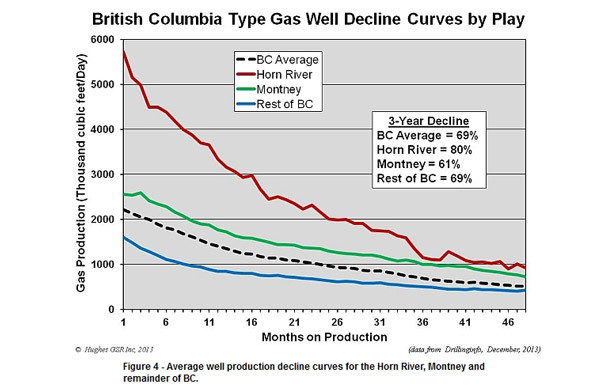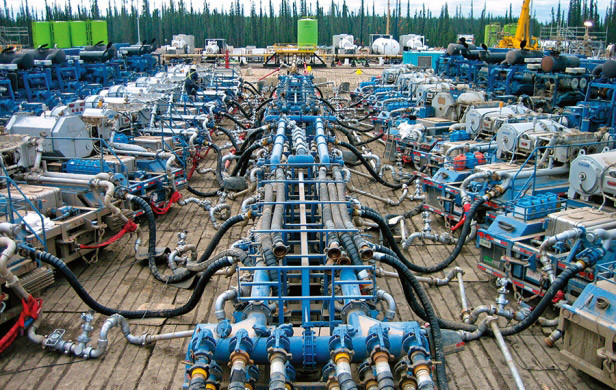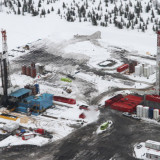
Despite admitting there is an increasing trend of inactive well sites awaiting reclamation, the BC Oil and Gas Commission has slashed its budget for its orphan site reclamation fund from $4.83 million in 2013 to just $1 million in 2014.
According to the Orphan Well Association, “an orphan is a well, pipeline, facility or associated site which has been investigated and confirmed as not having any legally responsible or financially able party to deal with its abandonment and reclamation.”
Earlier this year, the BC Ministry of Finance announced the 2014 Budget, focused on LNG development. According to the budget, the Liberals plan to spend $29 million over the next three years on LNG development alone. The National Energy Board also approved seven LNG export applications for BC, touted as the basis for a $100 billion Prosperity Fund that will wipe out the province’s debt by 2028.
In order to increase LNG development, the oil and gas industry will have to ramp up drilling, fracking and the number of LNG plants along the coast.
This push to expand LNG resources will create more orphan sites, but the government does not have the funds for reclamation because the Commission has scheduled to cut its cleanup expenditures. According to the BC Oil and Gas Commission’s 2014 Service Plan.
[quote]There is a trend of increasing inactive well sites awaiting reclamation as the industry matures. Delays in the implementation of restoration activities may increase the number of inactive sites and associated liabilities.[/quote]
Gas production in the province
In the northern BC regions of the Liard and Horn River Basins, and Montney shale field, the production from a natural gas well typically declines by 61 to 80-percent in just three years, according to geoscientist, David Hughes’ research. By that point, the well is all but played out, requiring far more drilling to keep up with production demands.

With the limited lifespan of these wells and the demand the LNG industry will place on fracking in BC, Hughes estimates industry will need to drill a staggering 50,000 new wells by 2040 – twice the total number in the 60 year history of the province’s natural gas industry.
That means the number of wells left behind will sharply increase. For example, the Horn River Basin gas well has a depletion rate of 80-percent in the first three years.
With a budget of $1 million until 2017, the BC Oil and Gas Commission will be unable to keep up with the demand for new sites as industry continues drilling, unable to account for the vast number of well pads reaching orphan stage, leaving more orphan well sites than they are able to responsibly reclaim.
Government and industry are driving a massive experiment in fracking and LNG development without being sure of the consequences for this scale of development.
For instance, in October the BC Ministry of Environment funded the $650,000 Kitimat Airshed Impact Assessment Project to measure the cumulative effects of existing and proposed industrial air emissions in the Kitimat Valley airshed. The SkeenaWild Conservation Trust accessed this research in their November 2013 “Air Advisory” report, concluding, “this research is being carried out under tight timelines and with a limited budget… raises concerns about whether current research can provide a comprehensive understanding of potential impacts on which to base sound decisions.”
The Kitimat airshed blockage from the current Rio Tinto Alcan aluminum smelter plant’s carbon dioxide emissions has demonstrated the link between human health problems and industrial air emissions in the area.
“It’s a new era and it needs to be spoken about differently than any other time you’ve done gas before,” says Eoin Madden, climate campaigner with the Wilderness Committee.
[quote] I had one call from Fort Nelson First Nation which described it as carpet-bombing. It’s taking wilderness and carpet-bombing it like you would have seen back in Vietnam. It’s that destructive.[/quote]
The concern is that shale gas and LNG are a very different animal from the historical conventional industry with which the province is so familiar.
“When folks hear LNG they don’t realize the danger and that we’re talking about a completely different product from what we’ve traditionally had in BC,” says Madden. “It’s the product that forces us to swap our fresh water for gas and it’s the product that forces us to industrialize enormous amounts of wilderness.”
The unknown consequences of orphan sites
Hydrologist, Dr. Gilles Wendling, presented the unknowns about groundwater in the Yukon in January to the Yukon legislative committee.
“We are extremely ignorant about groundwater,” said Wendling.
[quote]We don’t know where our aquifers are. Even shallow aquifers, we don’t know where they are, we don’t know how big they are, we don’t know how deep they are. We don’t know the water table elevation, we don’t even know in which direction the groundwater moves, we don’t know, we haven’t collected the information.[/quote]
The unknown dangers with old well sites come from the toxic water reserves created during hydraulic fracturing. Not all old well sites become orphan wells. The majority of them are injected with fracking fluid flowback that’s been mixed with toxic additives, such as ethylene glycol, methanol, hydrochloric acid, formaldehyde, mercury, uranium, and lead. The toxic flowback is then injected deep underground into old oil wells that haven’t become orphan sites. These types of wells that use this technique of deep oilfield injection are known as disposal wells. Disposal wells are old wells which use the drilling hole to dispose the leftover fluid from hydraulic fracking. These disposal wells are then sealed with concrete to prevent open exposure.

But wastewater-injected wells contain structural risks says Wendling. Active wells, disposal wells and orphan wells are all subject to native conditions, such as mini earthquakes, that create micro-fractures in the cement seals and corrosion in the casing of the well hole where leaks can happen a year to a decade as the structural integrity of the well degrades.
Well integrity is how wells are sealed and how a well’s sealing capacity will be modified with time.
“Once a hole is drilled in the ground, this hole is drilled forever,” says Wendling.
[quote]This hole goes through various zones which are under different pressures and which contain different types of fluids like gases, or liquids or a mix of the two. Once you have a hole that reaches through various zones and it’s properly sealed then it doesn’t act as a pathway, but with time and depending on induced anomalies, like mini-earthquakes, that cause fracturation – how is this going to effect the integrity of the well, how is it going to create micro-fractures along the well, how is it going to crack the cement seal along the well after one year, five years, ten years, 100 years, how is this going to change with time?[/quote]
If these disposal wells leak after deep oilfield injection, there is potential for our groundwater sources, that feed lakes and rivers, to become contaminated by these hydraulic fracturing chemicals because they can undergo pressure changes in the injection site that acts like a pathway for the mixing of deep and shallow water systems once the well’s integrity is jeopardized. There is a lot of research being conducted right now to grasp the risks associated with creating and connecting non-native pathways underground through drilling, but there are still a lot of unanswered questions about the dangers of disposal wells and orphan well sites, says Wendling.
Boom and bust economy
Hardy Friedrich, manager of communications for the Oil and Gas Commission in Fort St. John was given the opportunity to comment on the Commission’s plan for orphan well site reclamation but declined to comment in a phone interview.
“We shouldn’t get dragged into conversations about how much money should be spent reclaiming well sites,” says Madden. “Should the BC government spend money on that, or should Encana, or Talisman, or Apache, whoever made the mess? The way we’re thinking about it is endemic of how much ownership over our politics the oil and gas industry has.”
According to Madden, the dependence on the public to clean up after the energy industry reflects a fundamental problem in Canada’s fossil fuel economy.
[quote]The rules should state if you open a gas well, you’re responsible for remediation.[/quote]
However, that is not the case in BC. Taxpayer money is budgeted by the BC Oil and Gas Commission to reclaim orphan well sites so oil companies can move onto the next drilling project, but this allotted budget for environmental remediation is not enough to keep up with the demand for oil and gas.
In June 2013, Natural Resources Canada mandated that pipeline companies have at least $1 billion of cleanup funds available to deal with incidents. If the government of Canada is willing to make the polluter pay in the event of a pipeline spill, why doesn’t the government hold oil companies accountable for reclaiming their old well sites as well?
Alternative forms of energy for a sustainable economy and jobs
“The infrastructure I would advocate for right now is an infrastructure that shifts how we think about energy and how we create energy jobs,” says Madden.
[quote]You’ve got geothermal potential, wind, solar power, different ways you can make energy. The question mark is over whether we should even have an export energy market?[/quote]
With the current plan for LNG development there is not enough money in the budget to responsibly account for the necessary cleanup associated with LNG and shale gas development. Without this in place, the BC government risks running their fresh water supplies into the ground, along with their ability to deal with climate change.
“If you’re responsible on the environment, you’re going to create more jobs, that’s the truth,” says Madden.
According to Madden and other critics of LNG development, the government risks alienating public support for its LNG vision if it passes the buck for industry cleanup to taxpayers.


It’s genuinely very difficult in this busy lie to listen news on TV, so I simply
use web forr that reason, and obtain the ost recent information.
Keep onn writing, great job!
This article is extremely misleading and it is very dissappointing that the author did not take the time to gain a better understanding of the industry and the topics presented. As an employee of a large energy company, I deal with the BC Oil and Gas Commission on a daily basis and I can assure you, there are regulations in place and it is certainly a requirement for remediation and reclamation of every oil and gas site in the province. It is also dissappointing that there was no mention of the BC OGC’s Liability Management Program. I can attest that this program is strictly enforced by the BC OGC, regardless of how it may hold up industry activities. The orphan well program is to address old wells that have been left behind in the past, it is NOT so oil and gas companies can just move on without reclaiming the site. The Liability management program requires actual dollar amount security deposit from companies based on the amount of sites they have in the province to ensure that the money is in place to reclaim the sites.
It is very important to gather the correct information and quote reliable sources when publishing for the public to read and articles like this certainly damage the publics perception of resource development which the province of BC does very responsibly.
(P.S. Contrary to the caption, the first photo in this article does not include a single piece of “Fracking” equipment. Those are drilling rigs…)
Jay, there is nothing inaccurate in the author’s story.
Ms. McLaughlin stated a fact: the OGC’s orphan wells budget has been slashed. And that’s problematic. There are many wells in BC which at some point no longer have “any legally responsible or financially able party to deal with its abandonment and reclamation.” We can expect many more if the government’s LNG vision comes to pass – which expert geologist David Hughes predicts will spell 50,000 new fracked wells. So the timing of these cutbacks is ironic, to say the least.
https://commonsensecanadian.ca/shale-gas-expert-drills-50000-holes-bc-lng-plans/
This is the nature of our corporate, liability-limiting world. Wells and companies change hands over time, like a game of musical chairs. Petronas buys Progress, Progress buys Talisman, and someday, these assets will be sold yet again, and again, and again…and when the music stops at some point down the road, you can be sure there will be more orphaned wells.
Certainly, in the short run, there are requirements for remediation and reclamation. That’s not the time scale or situation discussed here.
The author did not at any point suggest orphaned wells are designed “so oil and gas companies can just move on without reclaiming the site.” Don’t put words in her mouth. The point is, whether intentional or not, it happens. And in the end, the taxpayer and environment are left to deal with the mess.
You also misquote the photo caption, which identifies the equipment broadly as “a fracking operation” – which it is. First comes the drilling, then comes the fracking, then the extraction, the attempt at remediation, and finally, the abandonment. The five steps of fracking in BC, don’t you know 😉
“5 steps of Fracking”? I think you are talking about the life cycle of a well (exploration-drilling-completions-production-abandonment-reclamation). Fracking is an operation that is a part of the completions stage, lasting only a few days, while the life of a well can exceed 30+ years.
While most are, not every well that is drilled is fracked, so i would caution using a picture of 2 drilling rigs and calling it a fracking operation…Don’t ya know 😉
I realize fracking is the hot button issue, but I’m sure you can understand that those in the industry are tired of natural gas development being simply called “Fracking”. We are not drilling “Fracking wells”, we are drilling “Natural gas wells”.
I don’t mean to put words in her mouth, however, the quote: “Taxpayer money is budgeted by the BC Oil and Gas Commission to reclaim orphan well sites so oil companies can move onto the next drilling project” is one I think most in the industry would dispute.
It is really unfortunate the OGC did not make themselves available for comment. I can tell you that their liability management program is strict and they are digging in their heels and simply declining the transfer of assets to companies who can not post the security deposits necessary to remediate the entire site. Major steps towards diffusing the “musical chair” issue you speak of, and getting a hold of the orphan asset situation.
I didn’t mean to attack the author, and perhaps came on too strong. I did not accuse the article of containing inaccuracies, i used the word misleading and still feel it is. I understand that some of this can be contributed to the OGC not providing their side of the story. If nothing else, this article would spark some serious debate between industry professionals, which I suppose is never a bad thing.
Thanks for the debate, back to work. Now I’ll stop defending the OGC and go back to battling them as per usual!
Thanks Jay. Glad you have a sense of humour and we appreciate your feedback.
It’s also good to hear from a producer about some proactive steps the OGC is taking, but, as you say, unfortunate they are so tight-lipped with media. You would think this would be a positive story worth telling…
On your point about “fracking”, I think it’s essential for the public to understand that going forward, most new development is going to be unconventional gas, i.e. fracking. We use this terminology so people don’t get lulled into the “Clean LNG” / “natural” gas story. Today, of the 4 Billion cubic ft/day we produce, we’re about 50-50 conventional vs. non, but if we want to fill those pipelines bound for Kitimat and Prince Rupert, it’s going to take a major ramping up of shale gas – and of the 50,000 wells we’re going to see by 2040, most will be fracked.
Now, you and I both know that the govt’s vision of 5 LNG plants by early 2020’s is nothing but a pipe dream, but if we’re having that conversation, we need to be clear where all this new gas is going to come from – and the enormous water and climate issues that will bring.
I urge you to check out geologist David Hughes work in these pages on the subject. We’re drawing on the very best available independent research here.
https://commonsensecanadian.ca/shale-gas-lng-exports-elephant-room/
https://commonsensecanadian.ca/shale-gas-expert-drills-50000-holes-bc-lng-plans/
Thanks for stopping by and engaging in some real dialogue with us. Please do come back. We do value your on the ground perspective, Jay 🙂
This is business .
Step1. Herald the cornucopia of benefits and blessing to come to the public.
Step2. Cry poverty to the government for as many taxpayer subsidies as possible.
Step3. Donate money to the government for the lowest royalty rates and taxes possible.
Step4. Hire as few people possible and use temporary foreign worker program to the fullest.
Step5. When all conceivable profit is extracted and a polluted husk is all that remains.
Abandon ship and let the taxpayers foot the billions and billions in clean up costs.
Can we take a vote to secede to Norway . Then maybe we can benefit from our resources.
The last question is key. Do we need to expand exports? Do we need exports on a grand scale? What are spending the money on that we are earning from exports? This week we are sending fighter jets to the Ukraine. It is a sign of our madness. We need to redirect our culture and the best way that I know of is to stop pretending that we are part of some grand New World scheme and direct our activities to our own citizens. The Big Idea won’t work. We want small. Small farmers, small manufacturers,and small business will be the path employing and engaging everyone in Canada. It will be our way ahead.
Industry has been walking away from these problems for 40 years. Make industry reclaim an existing abandoned well, road or pipeline as a requirement for a new license or lease. When they get a reclamation certificate for an old site, they get to develop a new lease.
So they don’t want to clean up after them selves??? don’t let them make a mess . Get out of the country!!!!! LIke F— OFF